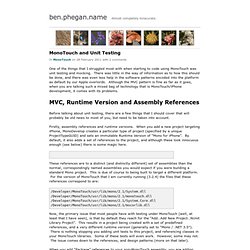

Ben.phegan.name - MonoTouch and Unit Testing. MonoTouch and Unit Testing In MonoTouch on 28 February 2011 with 2 comments One of the things that I struggled most with when starting to code using MonoTouch was unit testing and mocking.

There was little in the way of information as to how this should be done, and there was even less help in the software patterns encoded into the platform as default by our Apple overlords. Although the MVC pattern is fine as far as it goes, when you are talking such a mixed bag of technology that is MonoTouch/iPhone development, it comes with its problems. MVC, Runtime Version and Assembly References Before talking about unit testing, there are a few things that I should cover that will probably be old news to most of you, but need to be taken into account. Firstly, assembly references and runtime versions. These references are to a distinct (and distinctly different) set of assemblies than the normal, correspondingly named assemblies you would expect if you were building a standard Mono project.
Setting up Automated Builds with TeamCity, MonoTouch and TestFlight. We have recently entered the world of iOS development with MonoTouch and one of the first things I wanted to do was get a build process and Continuous Integration (CI) server up and running.

We already had CI setup for our existing Windows product which is integral to our development process so it was one of the first things we wanted to get working. I might write a more complete post of our build process another time but for the moment here are the details on how I set it up. I'm going to assume you have some knowledge of TeamCity, although even if you don't have any its pretty easy to use and worth learning.
I'm also if you use another build server it should be easy enough to apply the information here to it. Tools used TeamCity. Setting up the Mac as a Build Agent. First thing you need to do is set up your Mac as TeamCity build agent. Once you TeamyCity server can see the new build agent authorise it via the web interface as normal. Setting up the build process Update the App Bundle version. Cross-Platform Mobile Dev, pure badassery – pt 1. This is part 1 of a 5-part series in which I explore and demonstrate cross-platform app creation for mobile and desktop platforms using iFactr, an enterprise-grade framework, and Monocross, the open-source core of iFactr.

The other articles are easily accessible at the bottom of each post. Saw a tweet the other day referencing an article about how “Cross Platform UIs suck”… whatever. Aside from a personal bias (mostly because, in full disclosure, my livelihood kind of depends on it), I have a pretty straightforward thought on this: In my opinion this statement only holds up somewhat because up until this point those trying to do cross-platform UIs were just trying to implement a single codebase, then make it cross-platform. What if you had a team of people working on creating a way for you to write your code once, and translate it to run anywhere? It’s time to release the beast. full project structure I’ll let you soak up what you’re seeing there. iFactr Visual Studio 2010 templates.